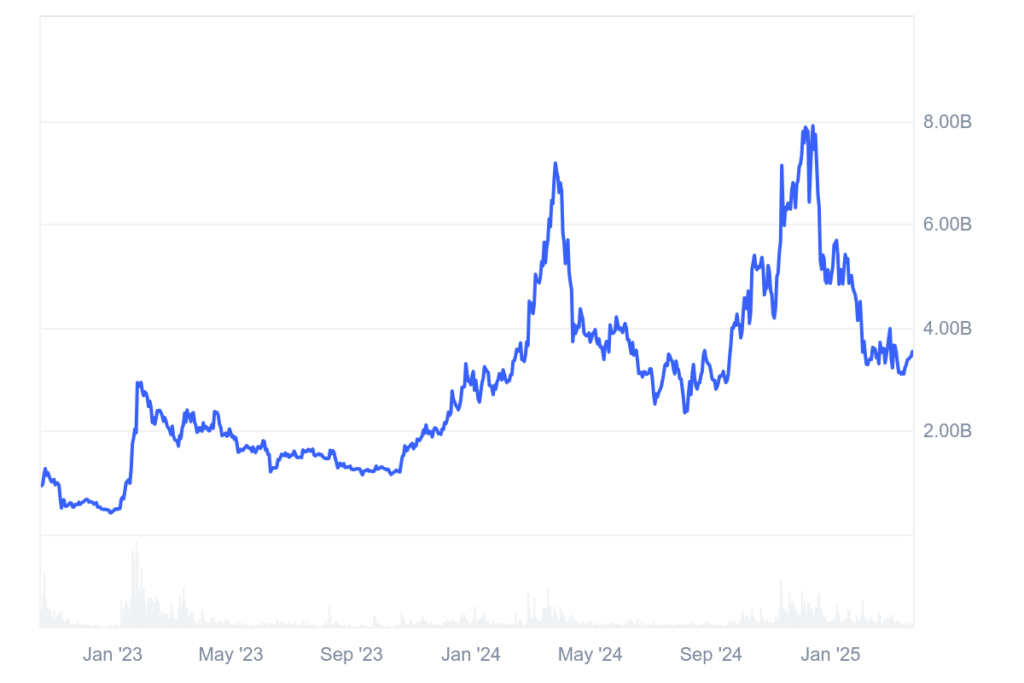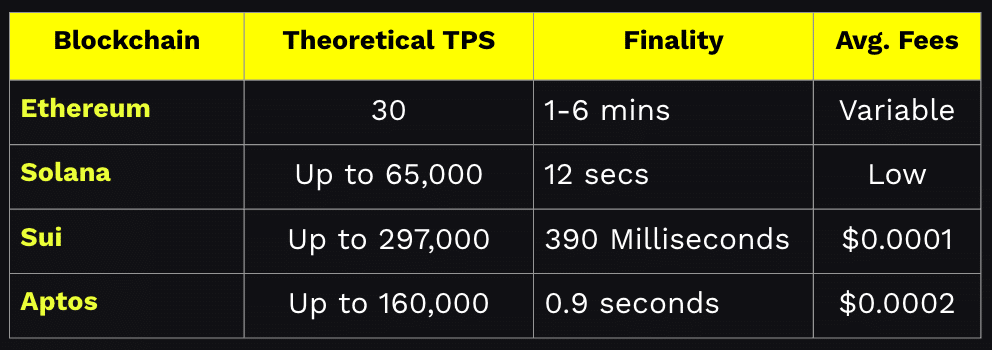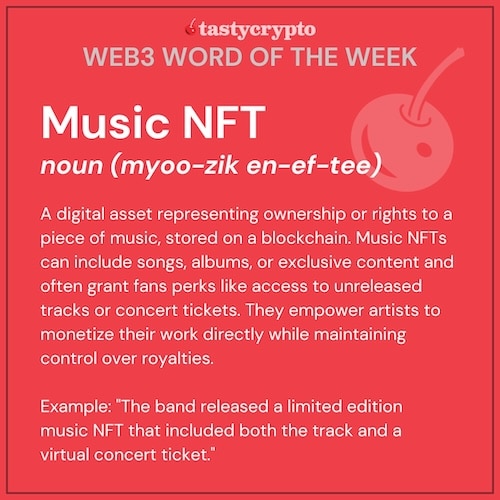Author: Ryan Grace
March 29, 2025
Good morning my tasty friends, I hope you’re all having a wonderful start to your weekend.

In the previous edition of Next to Orange, we laid out a high-level framework for how to think about the current market environment and the signals we’re looking for to get a sense of where prices might go next.
The cave has been cooking this week. As part of our new interview series on tastycrypto, we spoke with Professor Satoshi on X. Shelley and Dan dropped some alpha during BEANS per usual, and tastytrade has added more tokens to the repertoire with the launch of SUI and APT. We’re going to explore these shiny new tokens in today’s email.
Full disclosure, I own SUI and APT and you can also now trade these tokens at tastytrade. I’ve owned both long before they were available at tastytrade and we’ve discussed these on the network at times. I like the tech, as they say.
What Are SUI and APT?
Each cycle is different, every cycle is the same.
Apologies for constantly speaking in riddles. This is something I’ve been battling with since I was a child.
“Crypto” hasn’t been around very long. On one hand, bitcoin launched in 2009, but it didn’t reach popularity until 2017. Same with ETH. DeFi adoption picked up in 2020. Solana launched then, and NFTs were really more of a 2021 theme. A series of boom-bust cycles all condensed within a compact timeframe. Early stage technology adoption is a volatile process.
Across cycles there’s numerous narratives firing on all cylinders at the same time. Some narratives evolve into more tangible realities, markets react, and in the process there’s a resulting fervor. I’ve seen some crazy shit happen.
It’s not necessarily about getting each and every narrative correct, more importantly it’s about the awareness of the existence of these narratives. Narrative diversification if you will. Historically, price action will ultimately decide what’s real.
One narrative I want to shine light on today is this concept of Solana killers, or more appropriately Solana competitors. At one point SOL’s investment profile was simply “ETH killer” And we’re seeing a similar set emerge again. Fractals exist within narratives as well.
Now I’m not advocating for killers, but inevitably there will be competition among blockchain networks, depending on utility, use cases, etc. Sure, there’s a first mover advantage but there’s also room for competing networks to emerge. If we hone in on networks that are even cheaper, faster, more scalable. Higher performing blockchain compared to other L1s today… There’s a compelling investment theme.
If Solana was once dubbed an “Ethereum killer” for its high speed and low-cost transactions, then it’s fair to ask: could SUI and APT capture the attention of developers and users alike and become “Solana killers”? The comparison makes sense on the surface. All three are high-performance Layer 1 blockchains built for speed, scalability, and user-friendly developer environments. But to understand where SUI and APT fit in, and whether they pose a real threat to Solana – we need a little context.
SUI and APT (short for Aptos) are both Layer 1 blockchains built to scale crypto adoption by offering better performance and improved user experiences. What makes them especially interesting and comparable is that both were created by former Meta (Facebook) engineers who originally worked on the Diem blockchain, they both use the Move programming language, and both employ an approach to processing transactions through parallel execution.
Where these networks stand out is parallel execution. Parallel transaction processing lets these networks handle multiple transactions simultaneously without conflicts. This gives them the potential for better scalability and fewer bottlenecks. Solana achieves speed through a single global state and an innovative Proof of History consensus mechanism, but it has also faced performance instability and network outages in the past.
SUI and APT have a common origin and share some technical DNA, but they’ve taken slightly different approaches to parallel transaction processing in their effort to solve blockchain scalability and developer usability.
SUI uses an object-based architecture while Aptos has something called Block-STM.
SUI (Ticker: SUI)
SUI’s object-based architecture treats every asset or smart contract on the blockchain as its own object, like a separate folder or file. So, if two people are interacting with different objects, their transactions can be processed at the same time, without waiting for each other. This lets SUI process a huge number of transactions in parallel, making it really fast and able to reach finality almost instantly. That means once a transaction is done, it’s done. No long wait times or chances of reversal.
This approach makes SUI one of the fastest blockchains in the market. SUI’s token is used for gas fees, staking, and governance, and the project has quickly gained traction among developers building consumer-facing crypto apps.
Current Narrative: Positioned as a high-performance chain for consumer-grade applications. Some analysts see SUI as a strong competitor to Solana.
Target Use Cases: Gaming, NFTs, DeFi, and in theory any use case benefiting from ultra-fast user interactions and scalability.

Aptos (Ticker: APT)
Aptos also uses the Move programming language, but it takes a broader approach to blockchain infrastructure with a focus on flexibility, upgradability, and developer experience. Aptos uses a novel parallel execution engine called Block-STM, which also allows the chain to handle large volumes of transactions simultaneously while maintaining strong security guarantees. The APT token is used for network fees, staking, and governance.
Most blockchains process transactions one by one, in a single line. As a result, when lots of people are trying to use the network at once to transfer tokens or interact with smart contracts, or whatever, things can get slow and expensive.
Through Block-STM parallel execution, Aptos processes transactions differently. Similar to SUI, instead of waiting in line, many transactions are processed at the same time. This is kind of like having multiple checkout lanes at a grocery store instead of just one.
What makes Block-STM special is that it’s smart: it checks to make sure no transactions conflict with each other. If two transactions are trying to change the same thing at the same time, it knows how to handle that safely. The result? Faster speeds, lower fees, and the ability to scale to lots of users without breaking.
While still early in its adoption curve, Aptos has attracted attention as a potential platform for large-scale decentralized applications, spanning everything from DeFi and NFTs to social apps and enterprise use cases.
Current Narrative: Often seen as a more generalized Layer 1 that is still iterating, with an eye toward supporting complex decentralized applications at scale.
Target Use Cases: Broader scope, including DeFi, NFTs, enterprise-grade apps, and social platforms.

Perspective
Despite this novel approach to transaction processing, Solana still holds the edge in ecosystem strength, with real traction in DeFi, NFTs, and payments. SUI and APT are newer, and while developer activity is growing, they’re still at an early stage. Many in the industry see them as “Solana alternatives” rather than direct replacements at least for now.
Rather than thinking in zero-sum terms, I think we should view SUI and APT as part of a second wave of high-performance chains. Chains that are likely learning from the growing pains of Solana and aiming to improve upon its architecture. Their success will depend not just on speed and scalability, but on developer adoption, user experience, and ecosystem growth.
In my opinion it’s not chain vs chain. Here’s why:
We’re likely to see different chains for different use cases. In the future, there could be cohesion among chains and interoperability to an extent, but when looking at this from a user perspective, I don’t think there’s necessarily a one chain fits all scenario.
When Is Parallel Execution Better Suited (Aptos, Sui)? - Gaming or Social Apps with Many Independent Actions
Imagine an on-chain multiplayer game (like a Web3 version of Fortnite) or a social app like a decentralized Twitter. Every user is constantly doing small, independent actions:
- One player buys a skin
- Another sends a message
- Someone else levels up their character
- Someone likes a post
None of these transactions rely on each other. They can all be processed at the same time and benefit from parallel execution.
Because Aptos and Sui can identify transactions that don’t conflict and execute them simultaneously, blockchain based games or apps will become faster, more responsive, and scalable, even with many thousands of users interacting all at once.
When is Proof of History Better Suited (Solana)? - High-Frequency Trading or Order Book Matching
Now imagine a decentralized exchange (DEX) where every trade depends on the one that came just before it.
- Shelley places a limit order to buy SOL at $100.
- Ryan tries to sell SOL at $100.01.
- Dan wants to buy at $99.99.
In this case, the exact sequence of events matters. The trades need to be matched in the correct order.
Since Solana uses a cryptographic clock to establish a precise, immutable timeline, it can handle this kind of high-speed, order-sensitive environment more effectively. Using Proof-of-History, everyone agrees on what happened when.
APT vs SUI
The comparison between parallel execution and sequential execution is fairly straightforward, but how should we think about Aptos versus Sui?
SUI Example Use Case: High-volume gaming or social applications
Imagine an on-chain game where users are constantly buying and selling in-game items (represented as NFTs). These transactions don’t touch the same objects, one person’s sword sale doesn’t affect another’s shield purchase.
Again, Sui’s object-based architecture allows it to instantly process unrelated transactions in parallel without waiting for global consensus, enabling lightning-fast gameplay or social interactions.
Aptos Example Use Case: Complex DeFi applications
Let’s say you have a DeFi protocol where one user’s trade might affect another’s liquidity position, or where atomic execution and ordering matter a lot (e.g., lending, borrowing, yield farming).
Aptos’s Block-STM parallel engine allows it to parallelize execution, but it ensures all transactions go through consensus, preserving state consistency and preventing front-running or manipulation in critical financial logic.
Comparing Networks

Theoretical TPS refers to the maximum transactions per second the blockchain can handle under ideal conditions.
Transaction Finality is the time it takes for a transaction to be confirmed and considered irreversible.
Average Transaction Fee represents the typical cost per transaction on the network.
Comparing Networks
I think it makes sense to add SUI and APT to your watchlist, and we’ll see how this narrative plays out as this cycle matures. Remember, while the technology is compelling, price is the truth in markets.

Web3 Word of the Week (W3WOW)

Show Highlights
- The Digital Gold Rush is Rushing
- Blockchain battlefields–chain competition
- Lessons have been learned
- Help an mfer out of YouTube Jail
- There’s new art in the cave & we leaned into the cringe on BEANS


